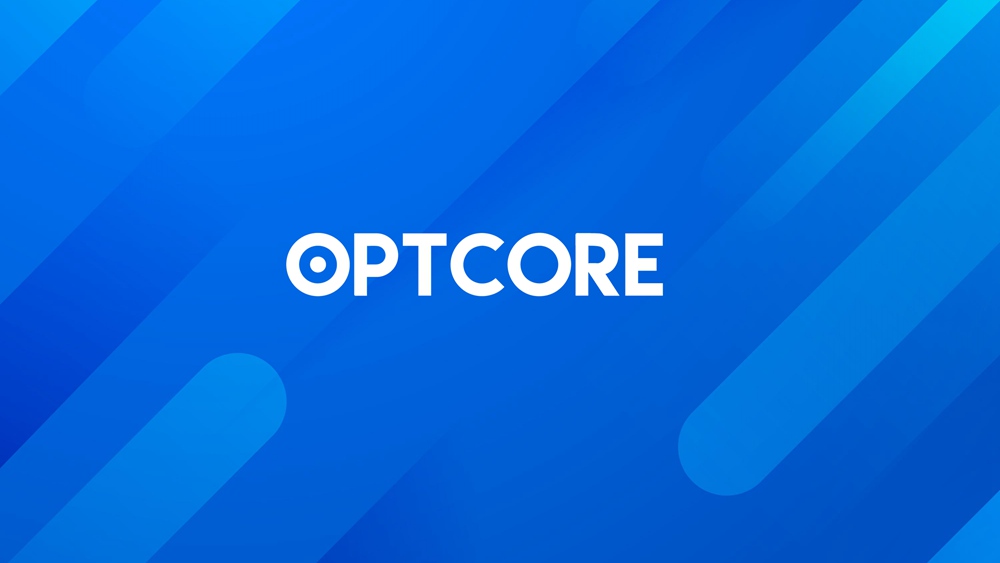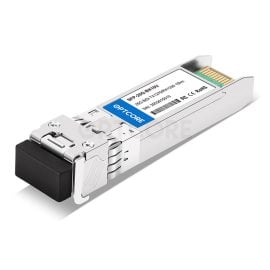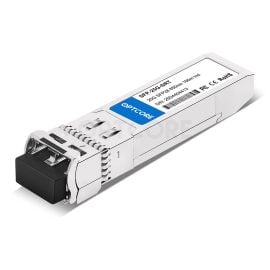Blog, Network Cabling, Optical Transceiver
What is 25 Gigabit Ethernet? A Beginner‘s Guide
Driven by the development of future-proofing technologies and applications, 25 Gigabit Ethernet (25GbE) has progressed at a continuous pace. More cloud computing companies, such as Google, also find their terminal devices in need of more than 10GbE capabilities. Besides, the 5G network has higher requirements for transceiver modules such as 25GbE SFP28 SR4 and LR4.
Therefore, a cost-effective gigabit Ethernet solution is crucial. This is because this solution has higher bandwidth and enhanced port density. This article introduces 25 Gigabit Ethernet, a potential replacement for 10 Gigabit Ethernet, providing valuable insights into this network protocol for beginners.
Table of contents
25 Gigabit Ethernet Definition
25 Gigabit Ethernet is a network standard developed by the IEEE 802.3 Task Force, also known as 802.3by, in 2014. Its main purpose is to make up for the low bandwidth of 10G and the high costs of 40G. 25G Ethernet also adopts single-lane 25G SerDes (Serializer-Deserializer) technology, supporting 25Gbps. Compared to 40G, which has four 10G lanes, 25 Gigabit Ethernet provides greater switch port density and network scalability. The 100G Ethernet is also based on four 25Gbps lanes.
25GbE physical interfaces are supportive of two major form factors, namely, SFP28 (1×25 Gbps) and QSFP28 (4×25 Gbps). Additionally, 25G matching equipment includes 25G Ethernet switches (some of which are backward compatible with 10G), 25G DAC cables, 25G adapters, 25G AOC cables, and breakout cables. Additionally, popular 25G Ethernet switches include those from Dell, Cisco, Juniper, Arista, and Mellanox.
As a one-stop shop for fiber optic solutions, OPTCORE offers a range of 25G SFP28 transceivers, DAC cables, and AOC cables.
1G vs. 2.5G vs. 5G vs. 10G vs. 25G vs. 100G Ethernet
There has been a rapid evolution of Ethernet technologies. A wide range of speeds can satisfy the ever-growing demands of various networking devices. The table below provides detailed information on the disparities between 1 GbE, 2.5 GbE, 5 GbE, 10 GbE, 25 GbE, and 100 GbE.
| Ethernet Type | 1G Ethernet | 2.5G Ethernet | 5G Ethernet | 10G Ethernet | 25G Ethernet | 100G Ethernet |
| Bandwidth | 1Gbps | 2.5Gbps | 5Gbps | 10Gbps | 25Gbps | 100Gbps |
| Compatibility | Widely supported | Backwards compatible with 1Gbps | Backwards compatible with 1Gbps and 2.5Gbps | Backwards compatible with 1Gbps, 2.5Gbps, and 5Gbps | Backwards compatible with 10Gbps | Limited backward compatibility with 10Gbps, 25Gbps, and 40Gbps |
| Expenses | Most cost-effective | Moderate | Backwards compatible with 1Gbps | More expensive than 5GbE | Slightly more expensive than 10GbE | Most expensive |
| Use Cases | Basic networking | Enhanced performance for gaming, streaming, and Network-Attached Storage | High-performance applications, advanced gaming, and streaming | Small and medium-sized enterprise networks | Costs more than 2.5GbE | Cloud centers and high-performance computing |
Benefits of Using 25 Gigabit Ethernet
High Performance and Scalability
10G Ethernet can support various deployments on the market, but it cannot deliver the bandwidth that web-scale and cloud organizations need with high efficiency. However, using 25 Gigabit Ethernet, these organizations can achieve 2.5 times the throughput per lane. Additionally, 40GbE utilizes four lanes, resulting in lower switch port density and network scalability compared to 25GbE.
Lower Operating Costs
The adoption of a 25 Gigabit Ethernet network enables enterprises and data centers to utilize fewer Ethernet switches and cables. It also saves on expenses spent on space, power, and cooling compared to 10GbE, 40GbE, and 100GbE. When enterprises transition from 10GbE to 25GbE, they can reuse the existing LC cabling to save the trouble of complex rewiring. This is because 25 Gigabit Ethernet has higher compatibility.
Future Upgrade Path to 100GbE Networks
Compared to 10GbE less efficient lanes, the IEEE has defined the 100Gb Ethernet standard on the basis of four 25Gb lanes. If data centers deploy 100G Ethernet networks, they will require the adoption of 25GbE technology.
Optcore Products for 25G Ethernet Connectivity
25G Ethernet is not only applicable to SFP28 and QSFP28 optical transceivers but also to 25G DAC cables and 25G AOC cables. These Ethernet devices have been quite popular among cloud data centers and 5G deployments.
With many years of experience serving global customers, OPTCORE supplies you with a wide selection of 25G SFP28 transceivers, DAC cables, and AOC cables.
Optcore 25G SFP28 Transceivers
25G SFP28 Transceivers: This type of transceiver is an enhanced variant of the SFP+ module. It is highly suitable for 25G Ethernet, telecommunications, and data centers. OPTCORE offers a wide range of options, including SFP28 SR, LR Lite, LR, ER, BiDi, CWDM, and DWDM variants. Here’s a table for your reference.
Notes:
SFP28 SR: “SR” is short for short range. It primarily utilizes OM4 multimode fiber and supports distances of up to 100 meters.
SFP28 LR: “LR” represents long range. It uses OS2 single-mode fiber to establish connectivity up to 10 kilometers.
SFP28 ER: “ER” means extended range. It works with OS2 singlemode fiber and offers transmission up to 40 kilometers.
SFP28 BiDi: “BiDi” refers to bidirectional. This transceiver is compatible with 25GbE Ethernet switches, routers, network interface cards (NICs), and storage networking equipment.
SFP28 CWDM: “CWDM” means Coarse Wavelength Division Multiplexing. It is used with Cisco 25 Gigabit Ethernet connectivity and CPRI 10 applications.
SFP28 DWDM: “DWDM” stands for Dense Wavelength Division Multiplexing. This module applies to 5G wireless front-haul network applications.
25G SFP28 DAC Cables: They comply with SFP28 MSA, SFF8402, and SFF-8431. We mainly offer you two types of SFP28 cables: Passive DAC (0.5m to 5m length) and Active DAC (1m to 9m length). They can help you make short-distance connectivity.
Optcore 25G SFP28 DACs
-
Cisco SFP-H25G-CU1M Compatible 1M 25G SFP28 Cable
US$ 13.00 (Excl. VAT) -
Cisco SFP-H25G-CU2M Compatible 2M 25G SFP28 Cable
US$ 16.00 (Excl. VAT) -
Cisco SFP-H25G-CU5M Compatible 5M 25G SFP28 Cable
US$ 32.00 (Excl. VAT) -
Dell DAC-SFP28-25G Compatible 25G SFP28 Passive DAC Cable
Price range: US$ 10.00 through US$ 25.00 (Excl. VAT)
25G SFP28 AOC Cables: You have many options for the types of these 25G AOC cables. They include SFP28 transceivers at both ends, along with OM3 or OM4 multimode fiber cables in various length ranges.
Optcore SFP28 AOCs
-
Cisco SFP-25G-AOC5M Compatible 5m (16ft) 25G SFP28 AOC
US$ 41.00 (Excl. VAT) -
Cisco SFP-25G-AOC30M Compatible 30m (98ft) 25G SFP28 AOC
US$ 55.00 (Excl. VAT) -
Mellanox MFA2P10-A001 Compatible 1m (3ft) 25G SFP28 AOC
US$ 38.00 (Excl. VAT) -
Mellanox MFA2P10-A005 Compatible 5m (16ft) 25G SFP28 AOC
US$ 41.00 (Excl. VAT)
FAQs
1. What types of 25GbE products are available on the market?
There is a relatively comprehensive line of 25GbE products, including 25GbE switches, 25GbE NICs, 25GbE SFP28, and 25GbE DAC or AOC cables.
2. Can SFP28 cables be plugged into SFP+ ports?
Of course. SFP28 has backward compatibility with SFP+ ports and functions well. SFP+ cables can be plugged into SFP28 ports; however, they are not designed for 25Gbps data rates.
3. What makes 25GbE more competitive for next-generation switch-server connections?
25 Gigabit Ethernet optimizes the bandwidth available from a switch-fabric design by providing a single-lane 25Gbps variant. Besides, it makes use of the existent module form factors (e.g., SFP28 and QSFP28). For this reason, 25GbE permits breakout connections that are configurable as either 25GbE per lane while supporting 100GbE without changing the port on the front of switches.
Conclusion
As 10GbE is not fast enough for switch-server connections, more data centers consider 25 Gigabit Ethernet instead. It can fit the requirements for faster speed and higher bandwidth. If you are seeking a cost-effective gigabit Ethernet network that meets the ever-growing demands, you can select the 25GbE. OPTCORE also has a wide selection of 25G SFP28 transceivers, DAC cables, and AOC cables. Browse our official website to choose what you need!
Reference
Read More
- What is 2.5 Gigabit Ethernet? A Beginner Guide
- What Is 100 Gigabit Ethernet? A Beginner’s Guide
- What is an SFP+ Module? An Ultimate Guide (2024)
- What is QSFP & QSFP28 Port? Everything You Need to Know












